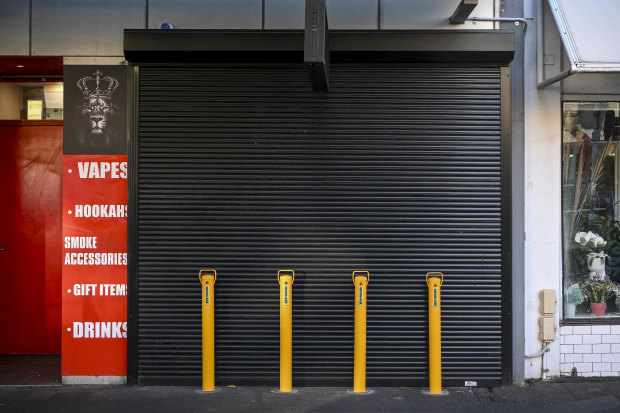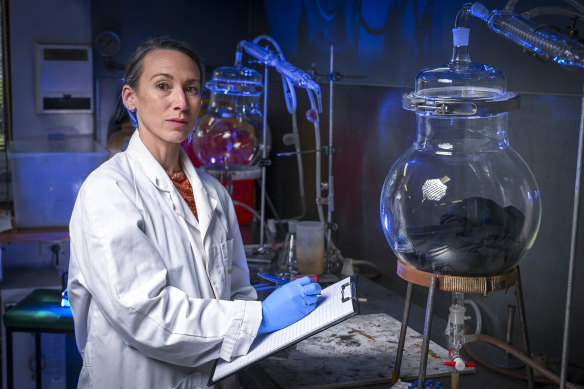This was published 3 months ago
How a failed bid to carve up Melbourne’s illegal tobacco trade sparked a violent war
A failed agreement among major crime players to set turf boundaries and split profit from the illicit tobacco trade ignited a war that has resulted in 100 firebombings and mounting violence.
Melbourne’s tobacco war erupted last year after a failed bid by some of the state’s most powerful organised crime players to establish a “commission” that would control and share the profits of the illicit cigarette trade.
New details about the outbreak of the war have emerged as the state recently marked more than 100 arson attacks linked to the dispute and the one-year anniversary of the establishment of Victoria Police’s specialised Lunar Taskforce.

Owners of tobacco shops have been “hardening” them against potential attacksCredit: Eddie Jim
Police now say the end game is bringing organised crime’s involvement in the lucrative trade down to a “manageable level” as they attempt to stem escalating violence, with some shop owners now arming themselves and fighting back.
Three police and underworld sources, who cannot speak on the record for operational or safety reasons, said a number of long-standing players in the illicit tobacco trade came together in early 2023 to try to form a cartel that would set turf boundaries and profit-sharing among members who were beginning to clash over control of an illicit industry worth hundreds of millions of dollars a year.
Among them was the reigning power, the underworld Haddara family, a syndicate dominated by Mohammed “Afghan Ali” Keshtiar, and bikie clubs including the Finks, Mongols and others. (Keshtiar was shot dead in South Yarra in August 2023.)
The sources say attempts to corner the market through a commission were almost immediately challenged by rising kingpin in exile Kazem “Kaz” Hamad, who is suspected to be behind a wave of firebombings, shootings and murders linked to the 18-month-old conflict.
Since then, authorities have struggled to contain the tit-for-tat violence and extortion, and stop the flow of illicit tobacco entering the country through the ports.
Despite more than 80 arrests by Victoria Police and record tobacco seizures at the border by federal authorities, the number of firebombings is now at the same level as a year ago, when the Lunar Taskforce was formed. Illicit tobacco and vapes are also still openly on sale around the state.
The state government, which pledged in March to implement a tobacco licensing scheme that is seen as key to stemming the illegal market, is yet to introduce the legislation to parliament.
There are concerns it could be at least 2026 before the government’s crackdown plan can begin because of the time and resources that will be needed to create a new state-based enforcement regime through the Department of Health or Department of Justice and Community Safety.
Authorities estimate there are at least 1300 specialty tobacco shops or tobacco retailers across the state, with more opening even in the midst of the “war”.
Premier Jacinta Allan has repeatedly refused to answer questions about when the legislation could come into force, telling reporters at a press conference on Tuesday: “We’ll be introducing legislation to the parliament before the end of the year.”
A spokesperson for the state government also declined to comment on when the licensing system would likely begin to operate.
Meanwhile, the violence has escalated as shop owners have begun defending their businesses from firebombings and standover attempts, prompting concern among police that it is only a matter of time before firearms become a feature of the conflict.
On Sunday night, would-be arsonists armed with machetes were driven off by a shop owner wielding an axe in Flemington. In a separate attack in August, a different tobacco shop was targeted in a drive-by shooting after being firebombed on three earlier occasions.
Other business owners have been “hardening” their shopfronts by installing anti-ramming bollards on public footpaths to prevent arsonists forcing entry into stores with cars.
In an interview with The Age, Detective Inspector Graham Banks said the problem wasn’t getting “any smaller” but conceded there was only so much police could do.
“There’s evidence these extortions are ongoing and some parts are escalating. And there’s concern it might escalate further,” Banks said.
“We’re recognising we can’t police every shop. The end game is a combination of pressure on the gangs and having a regulated market that will suppress the presence of organised crime – to make it so [gangs] can’t stand over it as easily. It has to be brought down to a manageable level.”
Banks said it should be treated the same as the liquor industry. “If you had a liquor industry that was not regulated or had no mechanism for enforcement, then you’d have the same issues.”
The pace of the violence slowed earlier this year, after a series of arrests of alleged syndicate lieutenants and the de facto surrender of the Haddaras – one of the war’s key players – following an intense firebombing campaign targeting their shops and legitimate businesses.
But new players, including the Sydney crime gang Brothers 4 Life, have emerged to fight for control of a share of the market, leading to a renewed surge in firebombings.
The war has also spread to Western Australia and South Australia, which have been plagued by a growing number of attacks.
Banks said there were more than a dozen players in the illicit tobacco importing and sales market, although the violence was being waged by a smaller number of “significant” players.
“It was never just a straight takeover of one business overnight. Once you get a disruptor like we’ve seen, it’s not just going to stabilise. They’re going to keep going to different stores and they can’t get to 1000-plus stores overnight.”
Intelligence from police and underworld sources suggests most bikie gangs are involved in the market to some degree, as well as Middle Eastern organised crime syndicates and smaller criminal groups.
The sources say illicit tobacco sales have also spread to some shops in the larger “corporate” or “branded” tobacco chains which have been struggling to compete in a market awash with cheap, illicit products.
Annual reports for Woolworths, IGA and major petrol chains suggest the market for the legal sale of tobacco has fallen by up to 19 per cent.
This is likely to be a drastic understatement given statistics are not collected for smaller retail chains and one-off owned stores that operate in the legitimate market. Some estimate the figure to be closer to 40 per cent.
The explosion in the scale and profitability of the illicit market has been driven by soaring excise tax rates that the federal government has levied on all forms of tobacco, and regulations that left enforcement in the hands of council workers.

Forensic officer Laura Noonan from the Victoria Police fire investigation unit.Credit: Eddie Jim
The government was collecting $1.36 a cigarette in tax in September 2024. A decade before, it was 46¢ a cigarette – almost a 200 per cent increase.
“A decade ago, there was money in tobacco, but nothing like this,” an underworld source told The Age. “The more the government jacks up the price, the more money there is.”
Police have also noticed a change in behaviour by arsonists, with the latest tobacco shop attacks far more damaging and effective than those launched at the start of the war.
Early in the conflict, attacks involved offenders attempting to smash through screened windows with hammers and bricks, or cracking open roller doors with pry bars. Petrol would be sloshed inside through the opening created.
Offenders would often light themselves on fire in the process, leaving behind burned clothing, gloves and shoes and a wealth of other evidence – lighters, petrol cans and entry tools with DNA traces – after they fled the scene, injured.
That began to change a few months into 2024 when the arsonists’ tool of choice became a stolen car, which could be more easily rammed through the facade or roller doors of a shop and then set alight and abandoned.
Forensic officer Laura Noonan said the scale and number of the fires had “certainly escalated”.
“The level of damage is far more significant. So it just indicates they’ve been thinking about it, and perhaps they’re learning from their previous efforts,” she said.
So far, no innocent parties have been seriously injured in the conflict, but police fear it’s only a matter of time before someone gets seriously hurt or killed.
Start the day with a summary of the day’s most important and interesting stories, analysis and insights. Sign up for our Morning Edition newsletter.